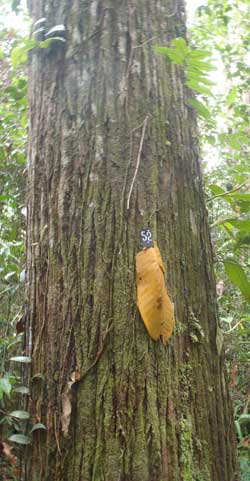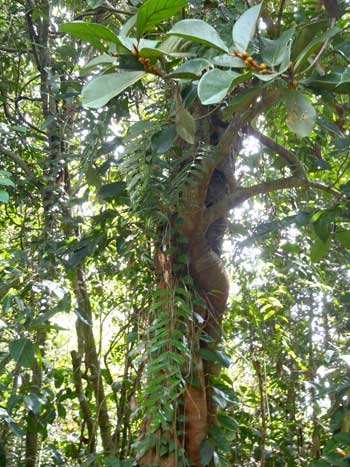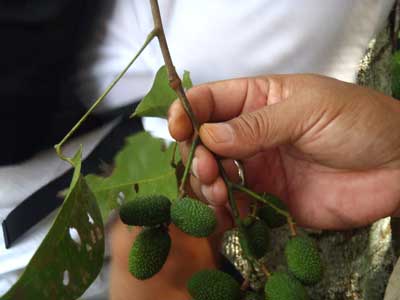BUKIT Lima Forest Park has many treasures to offer. In fact it’s really a kind of living museum. As we stroll or jog along the plank walks through this remnant of the vast peat swamp forest that once covered approximately 12 per cent of the state’s total landmass, we can glimpse some remaining specimens of trees that are part of Sarawak’s history.

SPECIES RICH: Meranti buaya (Shorea uliginosa) is one of the trees that can be found in the park.
Trees that were, and still are in some places, vital to the well-being of her denizens and others that in the past provided vast quantities of priceless natural resources.
Timber trees, species that were formerly tapped for latex, fruit trees, trees with medicinal uses and many other magnificent tall trees typical of peat swamp forest in Sarawak can all be found at Bukit Lima Forest Park.
Let us share with you some of the stars among the more than 40 species of forest trees, most of which are typical peat swamp species, that were ‘logged’ on a two-day inventory just along the plank walks.
Jelutong paya
Starting in about 1900, way before timber became an important export for Sarawak, Jelutong was the major export commodity. Jelutong is the latex obtained by tapping a species of peat swamp forest tree known as jelutong paya (Dyera polyphylla). Its close relative, D costulata, a tree of the lowlands of Sarawak, was also tapped for latex. The latex used to be an important ingredient of chewing gum.
One of Sarawak’s earliest pieces of forestry legislation, the Forest Rules, regulated the method of tapping jelutong trees. The magnificent columnar jelutong tree can get as tall 60 metres and reach a diameter of two metres.
Emerging near the tree’s base we can observe knee-shaped breathing roots (pneumatophores), an adaptation to existence in the waterlogged, oxygen-poor soil. At the other end, so to speak, the mature tree emerges from the main forest canopy and can thus take advantage of wind to disperse its seeds, which are appropriately adapted – flattened, with a broad membranous wing. Fine specimens of jelutong can still be seen at the forest park.
Ramin
Sarawak’s peat swamp forests were the first type of forests to be systematically exploited for timber. Peat swamp forest timber was important in many areas of Sarawak from the early 1950s. Ramin telur (Gonystylus bancanus) was one of the three main timber species during this period and was the major source of ramin timber (other Gonystylus species also produce ramin timber), extensively exploited and Sarawak’s principal export timber in the 50s and 60s. Logs were no longer exported after 1971.

FICUS BRACTEATA: This is an epiphytic strangling fig tree rare in Borneo.
The timber is pale, uniform and easy to work with and was widely used for mouldings and furniture. A ramin telur tree can reach 50 metres in height and one metre in diameter. Like jelutong paya, ramin telur also develops specialised knee-roots in waterlogged habitats and another interesting feature is the presence of irritant, protruding silky fibres seen when the inner bark is cut.
Ramin telur was often dominant in mixed swamp forest but is now classed as Vulnerable by the International Union for Conservation of Nature (IUCN). While the species is known to grow slowly, we were encouraged to note regeneration (saplings) at Bukit Lima Forest Reserve – maybe museum pieces for the future?
Alan
Alan (Shorea albida) is a member of the Dipterocarp family that has been the mainstay of Sarawak’s timber industry. Alan is unusual among primary forest species in Sarawak in that it occurs gregariously – many trees of the same species occur together.
The species was once abundant and dominated much of Sarawak’s peat swamp forests, especially in the Rajang Delta. Densely distributed alan trees were so characteristic of one particular sub-type of peat swamp forest that this sub-type became known as alan forest.
Alan trees may reach 75 metres in height and 2.5 metres in diameter. The species is endemic to (found only in) Borneo. Alan used to be one of the primary species logged in peat swamp forest, with exports starting in 1969.
The timber (alan batu, alan bunga, meraka) is dense, strong and hard. The remains of logged alan trees can be seen at a certain location along the plank walk at Bukit Lima Forest Park. They are easily recognised by their large size, steep buttresses, hollow trunks and gregarious occurrence.

FOREST FOOD: The Xerospermum laevigatus has a spiny fruit that is edible.
The species is now classified as Endangered by IUCN. A very fine living specimen can be seen right next to the plank walk.
The majority of tree species that are an integral part of the peat swamp forest ecosystem have no particular claim to economic fame – they don’t produce exploitable and exploited natural resources.
Some may have played an important role in the traditional lifestyles of yesteryear, maybe in construction, or to make particular household articles, or as dyes or poisons. Some still do play an important role as food for humans and wildlife.
However, just because we cannot see a use or value for each species, shouldn’t stop us from enjoying and celebrating the wonderful diversity and amazing adaptations of our peat swamp forest species, still to be seen flourishing at Bukit Lima Forest Park.
The Malaysian Nature Society
Established in the 1940, the Malaysian Nature Society is the oldest scientific and non-governmental organisation in Malaysia. Our mission is ‘to promote the study, appreciation, conservation and protection of Malaysia’s nature heritage’. Our 5,000-strong membership, spread across 12 branches nationwide, come from all walks of life, bound by a common interest in nature. For further information on membership or our activities in Kuching, call Kwan on 019-8349499. For information on our activities in Miri, call Nazeri Abghani on 085-453185. You can also visit www.mns.org.my or
http://[email protected].
